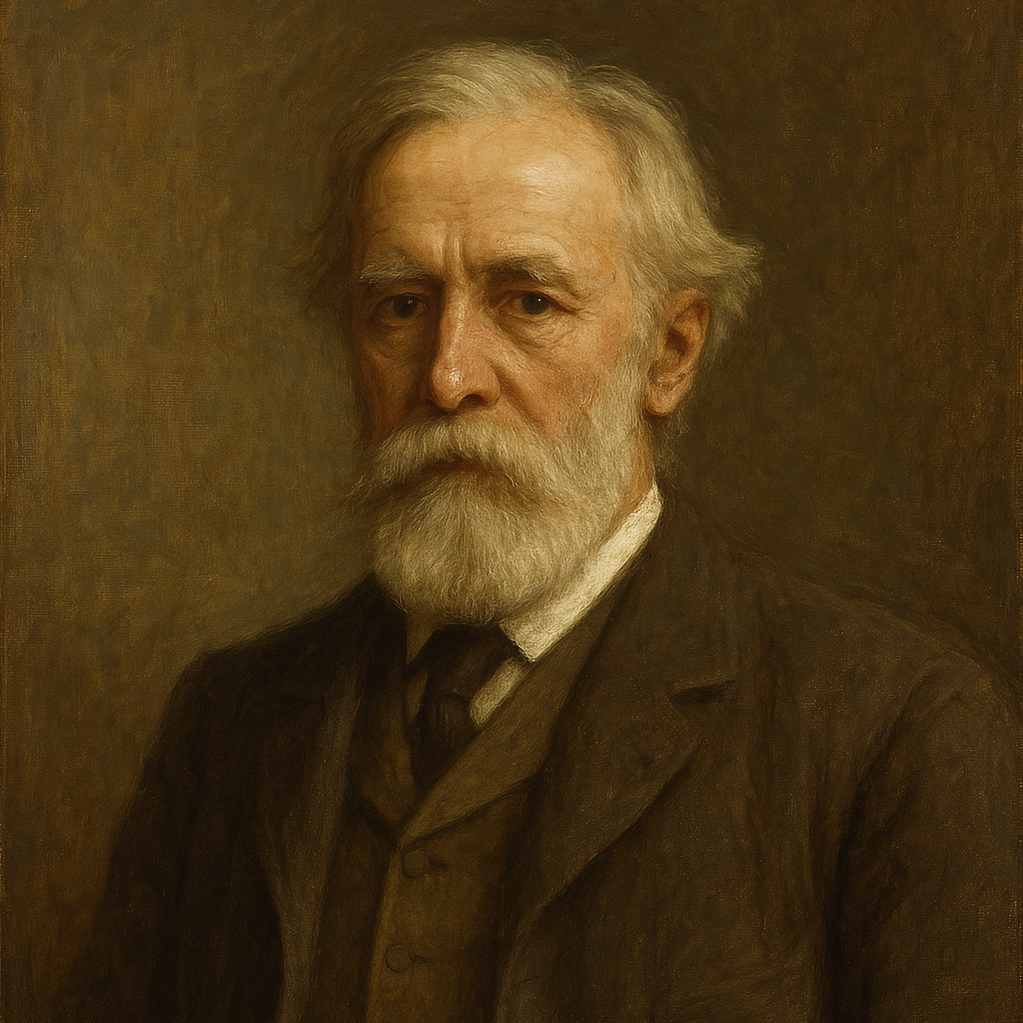Clear and Gentle Stream
Robert Bridges
1844 to 1930

Clear and gentle stream!
Known and loved so long
That hast heard the song,
And the idle dream
Of my boyish day;
While I once again
Down thy margin stray,
In the selfsame strain
Still my voice is spent,
With my old lament
And my idle dream,
Clear and gentle stream!
Where my old seat was
Here again I sit,
Where the long boughs knit
Over stream and grass
A translucent eaves:
Where back eddies play
Shipwreck with the leaves,
And the proud swans stray,
Sailing one by one
Out of stream and sun,
And the fish lie cool
In their chosen pool.
Many an afternoon
Of the summer day
Dreaming here I lay;
And I know how soon,
Idly at its hour,
First the deep bell hums
From the minster tower,
And then evening comes,
Creeping up the glade,
With her lengthening shade,
And the tardy boon,
Of her brightening moon.
Clear and gentle stream!
Ere again I go
Where thou dost not flow,
Well does it beseem
Thee to hear again
Once my youthful song,
That familiar strain
Silent now so long:
Be as I content
With my old lament
And my idle dream,
Clear and gentle stream.
Robert Bridges's Clear and Gentle Stream
Introduction
Robert Bridges' poem "Clear and Gentle Stream" is a masterful exploration of memory, nostalgia, and the passage of time, set against the backdrop of a tranquil stream. This lyrical piece, with its gentle rhythm and evocative imagery, invites readers into a world where past and present converge, offering a profound meditation on the human experience of aging and reflection. Through a careful analysis of the poem's structure, language, and themes, we can uncover the deeper meanings and artistic choices that make this work a significant contribution to English poetry.
Structure and Form
The poem consists of four stanzas, each containing twelve lines. This consistent structure provides a sense of stability and flow, mirroring the steady movement of the stream that serves as the poem's central image. The rhyme scheme (AABCCBDDEEAA) is intricate and adds to the musical quality of the verse, creating a melodic undercurrent that echoes the gentle babbling of the water.
Bridges' use of repetition, particularly in the first and last stanzas, creates a circular structure that reinforces the poem's themes of return and continuity. The repeated phrases "Clear and gentle stream" and "idle dream" serve as anchors, tying the beginning and end of the poem together and emphasizing the timeless nature of the speaker's connection to this place.
Imagery and Symbolism
The stream itself is the poem's most prominent symbol, representing both the constancy of nature and the flow of time. It serves as a physical link between the speaker's past and present, remaining unchanged while he has aged. The "long boughs" that form "translucent eaves" over the water create a sense of shelter and intimacy, suggesting that this place serves as a sanctuary for the speaker's memories and reflections.
Bridges employs rich natural imagery throughout the poem, painting a vivid picture of the stream and its surroundings. The "back eddies" playing "shipwreck with the leaves" and the "proud swans" sailing "out of stream and sun" create a dynamic scene that contrasts with the speaker's stillness, highlighting the tension between movement and stasis that underlies the poem.
The progression from afternoon to evening in the third stanza serves as a metaphor for the passage of time in the speaker's life. The "deep bell" that "hums from the minster tower" marks the hours, while the encroaching darkness and the "brightening moon" suggest the approach of life's twilight years.
Themes of Memory and Nostalgia
At its core, "Clear and Gentle Stream" is a poem about the power of memory and the bittersweet nature of nostalgia. The speaker returns to a place from his youth, finding it largely unchanged while he himself has aged. This juxtaposition allows for a poignant exploration of the ways in which our past selves continue to exist within us, even as we move through life.
The repeated mention of the "idle dream" and "youthful song" suggests that the speaker is revisiting not just a physical location, but also the aspirations and emotions of his younger self. There's a sense of loss in the acknowledgment that this "familiar strain" has been "silent now so long," yet also a comfort in the ability to reconnect with these past experiences.
The Passage of Time
Bridges deftly weaves the theme of time's passage throughout the poem. The contrast between the speaker's "boyish day" and his current state is implicit but powerful. The stream, which has "heard the song" of his youth, becomes a witness to the changes in the speaker's life, while remaining itself unchanged.
The third stanza's description of a typical summer afternoon evolving into evening serves as a microcosm for the larger passage of time in the speaker's life. The "tardy boon" of the "brightening moon" suggests that there is beauty and value to be found in later life, even as youth fades.
Language and Tone
The language of the poem is characterized by its simplicity and musicality. Bridges employs a vocabulary that is largely monosyllabic and Anglo-Saxon in origin, giving the verse a direct and unadorned quality that enhances its emotional impact. This simplicity of language contrasts with the complexity of the emotions and ideas being expressed, creating a tension that adds depth to the work.
The tone of the poem is contemplative and melancholic, yet not without a sense of peace and acceptance. There's a gentleness to the speaker's reflections that mirrors the "clear and gentle stream" itself. This tonal quality suggests that while the passage of time brings inevitable changes and losses, it can also bring a kind of serenity and perspective.
Philosophical Underpinnings
Underlying the poem's surface narrative is a subtle exploration of philosophical questions about identity, continuity, and the nature of existence. The speaker's return to the stream raises questions about the relationship between our past and present selves. Are we the same person we were in our youth, or have we fundamentally changed? The poem suggests that while we may change over time, there is a core of identity that remains constant, much like the stream itself.
Furthermore, the poem touches on the Heraclitean concept that one can never step into the same river twice. While the stream appears unchanged, the water flowing through it is always new. This serves as a metaphor for the way our memories and past experiences continue to shape us, even as we move forward in time.
Literary Context
"Clear and Gentle Stream" can be situated within the broader context of English Romantic poetry, with its emphasis on nature, personal emotion, and the power of memory. Bridges, writing in the late 19th and early 20th centuries, draws on this tradition while infusing it with a more modern sensibility.
The poem's themes and imagery invite comparisons to works like Wordsworth's "Tintern Abbey," which similarly explores the relationship between memory, nature, and the passage of time. However, Bridges' approach is more restrained and introspective, reflecting the changing literary sensibilities of his era.
Conclusion
Robert Bridges' "Clear and Gentle Stream" is a masterful exploration of memory, time, and the human experience of aging. Through its carefully crafted structure, evocative imagery, and thoughtful engagement with universal themes, the poem offers readers a deeply moving meditation on the relationship between past and present.
The work's enduring appeal lies in its ability to capture the complex emotions associated with revisiting our past selves and the places that have shaped us. By focusing on the constancy of nature as represented by the stream, Bridges provides a framework for understanding our own changes and continuities over time.
Ultimately, "Clear and Gentle Stream" reminds us of the power of place and memory in shaping our identities and our understanding of ourselves. It invites us to reflect on our own "idle dreams" and "youthful songs," and to find comfort in the enduring beauty of the natural world. In doing so, it offers a poignant and deeply human perspective on the passage of time and the nature of existence itself.
This text was generated by AI and is for reference only. Learn more
Want to join the discussion? Reopen or create a unique username to comment. No personal details required!



Comments
No comments yet. Be the first to comment!